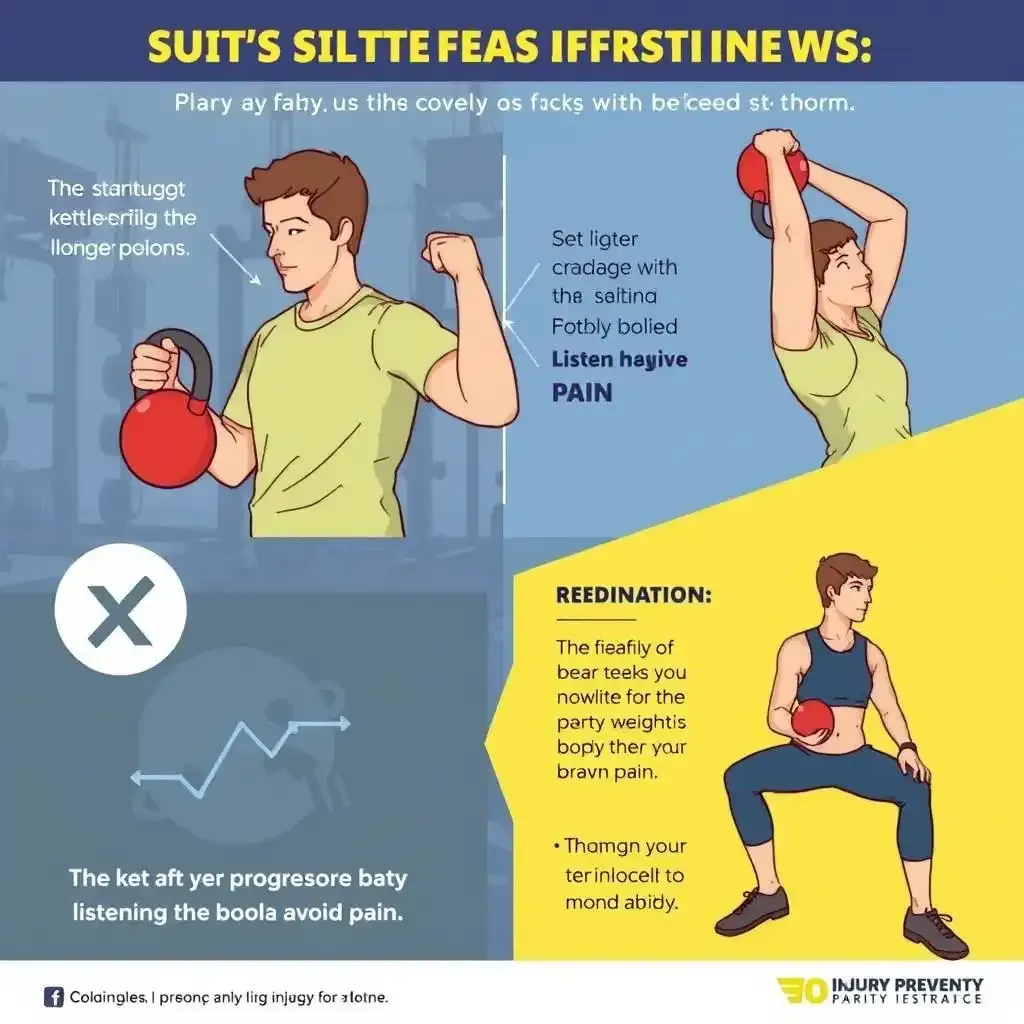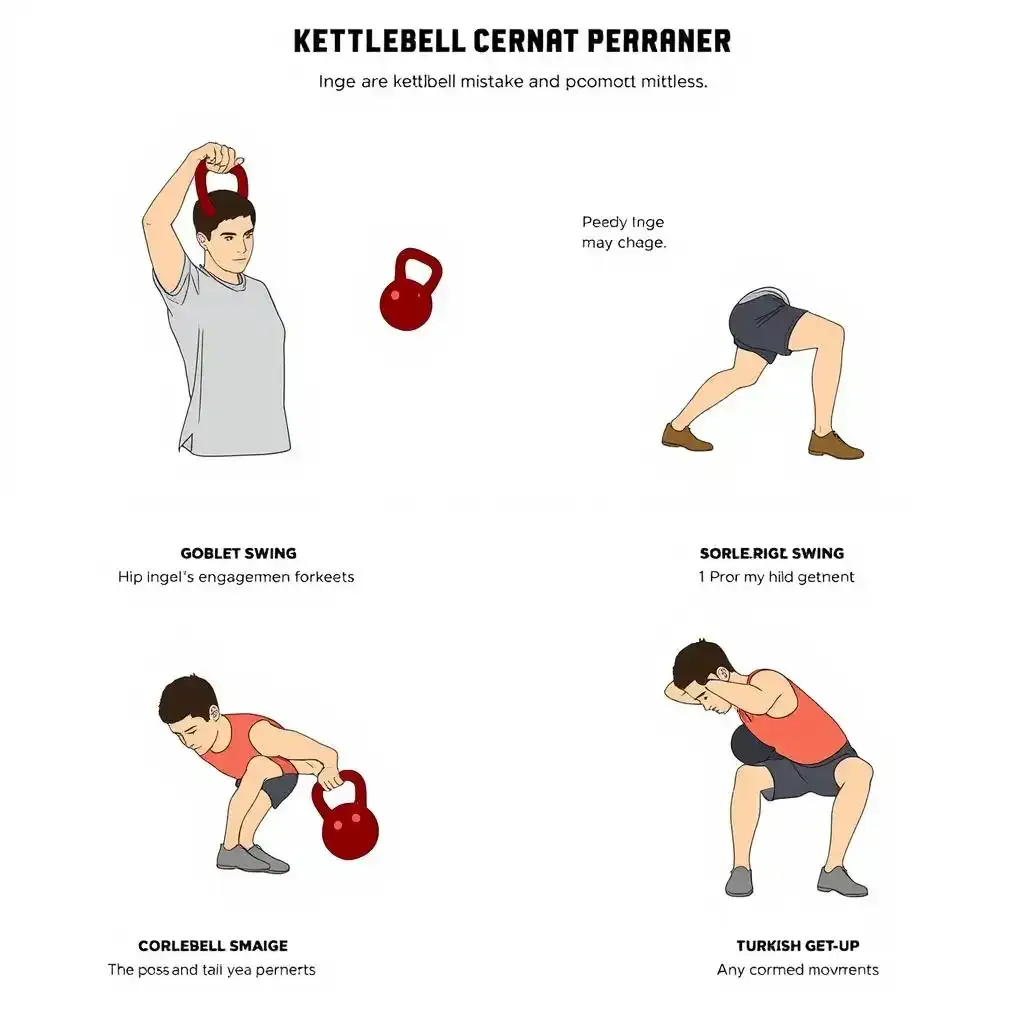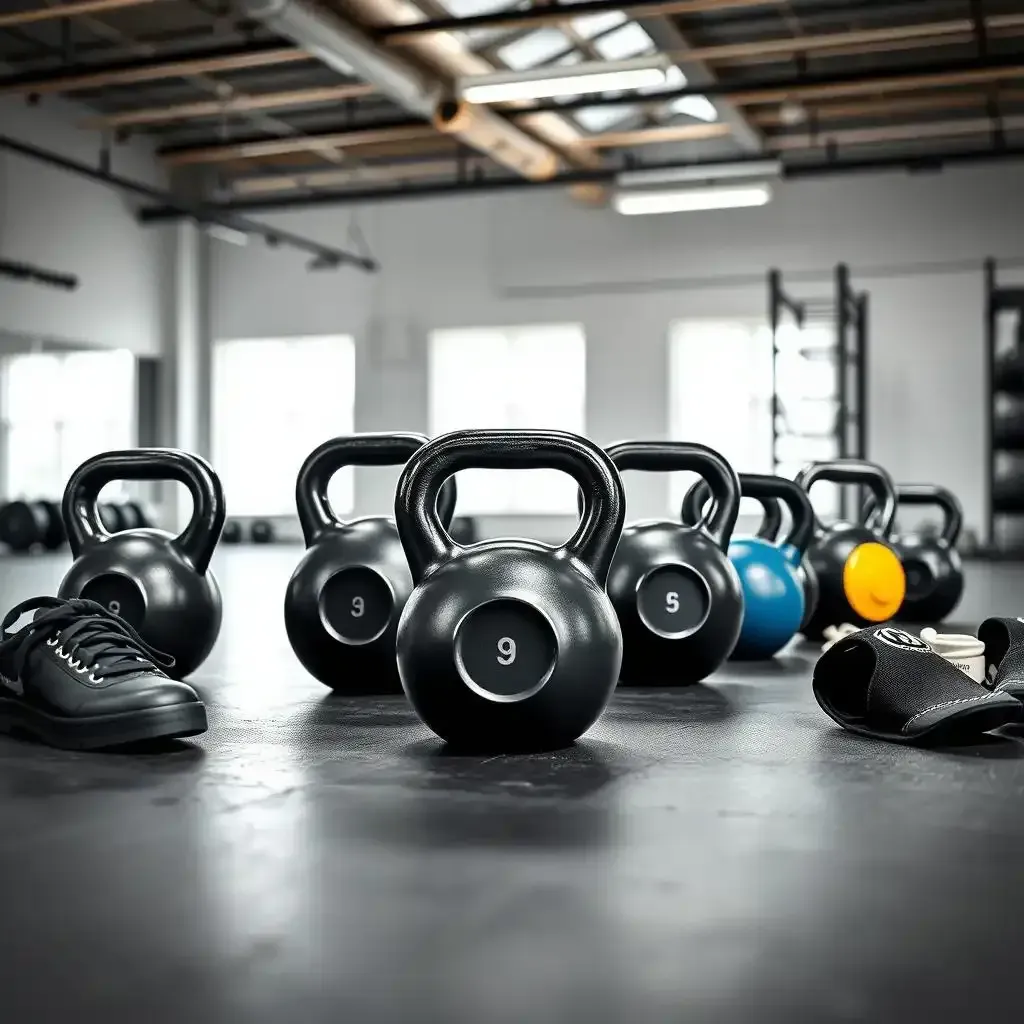Table of Contents
Are you new to kettlebell workouts, or maybe you've been swinging away for a while? No matter your experience level, kettlebell injury prevention should always be a top priority. At kettlebellworkout.homes, we're dedicated to helping you stay safe and strong. In this article, we’ll break down the basics of injury prevention, the importance of proper form, how to choose the right equipment, and advanced techniques to keep you in top shape. Whether you're a seasoned athlete or a beginner, these tips will help you achieve your fitness goals without sacrificing your health.
Kettlebell Injury Prevention: The Basics

Kettlebell Injury Prevention The Basics
Starting Smart: Your Kettlebell Progression Begins
Hey there, fellow kettlebell enthusiast! So you're diving into the world of kettlebells – awesome! But before you go snatching and swinging like a pro, let's talk safety. Think of your body like a finely tuned sports car; you wouldn't race it without a check-up, would you? Same goes for kettlebell training. We need to lay a solid foundation. It’s not about brute strength; it’s about smart strength.
Start with lighter weights than you think you need. Seriously! Don't try to impress anyone on your first day. Think of it like learning to ride a bike – you wouldn't hop on a Harley-Davidson right away, right? You'd start with a tricycle, then a smaller bike, and eventually build up to a bigger one. Same principle applies here. Gradual progression is key. Check out our kettlebell weight guide for more details!
Weight | Recommendation |
|---|---|
8kg (17.6 lbs) | Perfect for beginners |
12kg (26.5 lbs) | Intermediate level |
16kg (35.3 lbs) | Advanced |
Listen to Your Body: It's Not a Competition
This might sound obvious, but it's crucial. Your body is talking to you constantly. Pay attention! Pain is a big red flag. Don't push through sharp pains; that's a recipe for disaster. A little muscle soreness is normal, especially when starting, but that’s different from actual pain. Think of it like this: a tiny scratch on your knee might sting a bit, but a deep cut needs a band-aid and rest. Pain is your body's way of screaming "STOP!"
If you feel any unusual twinges or discomfort, stop your workout immediately. Don't be a hero; there's no medal for pushing through pain. Remember that consistency is key. You're in this for the long haul, not for a single, grueling session. A missed workout is better than a major injury. For more on getting started safely, check out our kettlebell basics guide.
- Rest when you're tired.
- Don't ignore pain.
- Listen to your body.
Proper Form is Your Best Friend: Technique Trumps Weight
I know you're eager to lift heavy, but proper form is way more important. It's like baking a cake; you can't just throw all the ingredients together and expect a masterpiece. You need the right recipe and technique. Poor form leads to injuries. Period. Start with the basics. Watch videos, take a class, have someone experienced watch your form. There are tons of resources available online and in person.
Think of your body as a chain. The strength of the chain is only as strong as its weakest link. If you have poor form, you’re creating weak links in your chain, making you more prone to injury. Focus on controlled movements. Slow and steady wins the race. Don't rush. Master the technique before you add weight. You can find more advice on proper form in our kettlebell form guide!
Proper Form and Technique for Kettlebell Safety

Proper Form And Technique For Kettlebell Safety
Okay, so you're ready to rock those kettlebells, huh? Awesome! But before we free the inner beast (responsibly, of course!), let's talk technique. Think of it like this: you wouldn't try to build a skyscraper without blueprints, would you? You'd end up with a wobbly mess! Proper form is your blueprint for a safe and effective kettlebell trip. It’s not about how much weight you lift, it’s about how *well* you lift it. We're aiming for smooth, controlled movements, not jerky, uncontrolled chaos. Imagine a graceful dancer, not a clumsy oaf flailing around a heavy weight. That's the vibe we're going for.
Start slow and focus on mastering each movement. You might feel a bit silly at first, moving slowly with a light weight, but trust me, your future self will thank you. Think of it as your body's warm-up to the heavier lifts. There's tons of great online resources to help you learn proper form for different exercises, like the kettlebell swing, goblet squat, or Turkish get-up. Check out our for more details! It’s like learning a new dance move – you wouldn’t try to do a complicated routine without practicing the basics first, right?
- Watch videos of proper form.
- Start with lighter weights.
- Focus on controlled movements.
One common mistake is using your arms too much. The capability should come from your legs and core – think of it like using your whole body as one powerful machine. If you're just using your arms, you're putting unnecessary stress on your shoulders and elbows. For example, in a kettlebell swing, the capability should come from your hips, not from your arms. Your arms are just there to guide the kettlebell. It’s like throwing a baseball – you don’t just use your arm; you use your legs and core to generate capability. This will not only help you to prevent injuries, but it will also help you to lift heavier weights over time. Want to learn more about building a solid foundation? Check out our !
Another key aspect is engaging your core muscles throughout the entire movement. Your core is your powerhouse, providing stability and support. It's like the center of a wheel; without a strong core, everything else wobbles. A strong core will help you to maintain proper form and prevent injuries. It's also super important to breathe properly – exhale during the exertion phase of the movement, and inhale during the recovery phase. It's like fueling your engine. Need some extra tips to help you with your breathing? Check out our breathing techniques guide to help you out!
Exercise | Focus | Common Mistake |
|---|---|---|
Kettlebell Swing | Hip hinge, core engagement | Using arms to generate ability |
Goblet Squat | Chest up, knees out | Rounding your back |
Turkish Get-Up | Controlled movement, core stability | Rushing the movement |
Choosing the Right Kettlebell and Equipment

Choosing The Right Kettlebell And Equipment
Kettlebell Types: Finding Your Perfect Match
So, you're ready to get your kettlebell on? Awesome! But before you grab the first one you see, let's talk kettlebell types. It's like choosing a pair of shoes – you wouldn't wear running shoes for hiking, would you? Different kettlebells are designed for different purposes and preferences. You've got your cast iron kettlebells, the classic heavy hitters. They're durable, affordable, and widely available. Then there are vinyl-coated kettlebells, softer on the floor and quieter during workouts. And if you're really fancy, there are competition kettlebells with a slightly different design for those serious about competitions. Think of it like picking the right tool for the job – a hammer is great for nails, but not so much for screws!
Your choice depends on your budget and your workout style. If you're just starting out, a vinyl-coated kettlebell might be a good choice, as they're gentler on floors and your joints while you’re still figuring things out. But if you're planning on becoming a kettlebell ninja and want to lift heavier weights, cast iron is the way to go. For more beginner-friendly tips, check out our . Remember, the right kettlebell will make your workouts safer and more enjoyable. Don't rush into buying an expensive set before you’re sure about your commitment to the sport.
Kettlebell Type | Pros | Cons |
|---|---|---|
Cast Iron | Durable, affordable | Can be heavy, noisy |
Vinyl-Coated | Quieter, gentler on floors | Less durable, can be more expensive |
Competition | Specific design for competitions | More expensive, may not be necessary for beginners |
Beyond the Bell: Essential Gear and Accessories
Okay, so you've picked your kettlebell. But hold on, we're not done yet! There are a few other things that can make your workouts safer and more comfortable. Think of it like this: you wouldn't go rock climbing without a harness, would you? Similarly, there are some essential accessories to consider for your kettlebell process. A good pair of workout shoes with solid support is a must. You need that stable base to prevent injuries. Imagine trying to do a squat in flip-flops – not a good idea! You'll also want comfortable clothing that allows for a full range of motion. Nothing too restrictive, or you'll end up feeling like a sausage in a casing!
Depending on your workouts, you might also consider things like wrist wraps for extra support, especially when dealing with heavier weights. Knee sleeves can be a good idea too, especially if you have any pre-existing knee issues. And lastly, a good workout space is key – enough room to swing that kettlebell without hitting anything or anyone. To get more tips on starting out, check out our beginner kettlebell workout guide. A little extra prep goes a long way in preventing injuries and making your workout more enjoyable.
- Workout shoes with good support
- Comfortable clothing
- Wrist wraps (optional)
- Knee sleeves (optional)
- Adequate workout space
Advanced Techniques for Injury Prevention

Advanced Techniques For Injury Prevention
Mastering the Kettlebell Swing: Beyond the Basics
Okay, so you've nailed the basic kettlebell swing. High five! But there's a whole universe of variations out there, each adding new challenges and benefits. Think of it like learning to play the guitar – you start with simple chords, then move onto more complex riffs and solos. With kettlebell swings, we can adjust the swing itself for more intensity, or we can add more complex variations to make it more challenging. For example, the Russian kettlebell swing is a bit different from the American kettlebell swing. The Russian kettlebell swing is more of a capability exercise, while the American kettlebell swing is more of an endurance exercise. By learning these variations, you'll be well on your way to becoming a kettlebell pro.
One way to level up is to experiment with different grips. A wider grip, for example, can challenge your grip strength and stability, leading to increased strength and improved form. But be careful – it also increases the risk of injury if you’re not used to it. Start with a grip you’re comfortable with, and gradually increase the width as you gain strength and confidence. Remember, it’s always better to start slow than to rush into things. If you start to feel pain, STOP! Your body will thank you for it. Learning advanced kettlebell techniques isn't just about brute force; it's about smooth, controlled capability. For more information on kettlebell variations, check out our advanced kettlebell routines guide.
- Experiment with different grips.
- Practice different swing variations.
- Focus on controlled movements.
Adding Complexity: Beyond the Swing
Once you're comfortable with the swing, it's time to explore other kettlebell exercises. These exercises challenge different muscle groups, improving overall strength and balance. Think of it like building a house – you start with the foundation (the swing), then add the walls (other exercises) to make it a complete structure. This will not only make your workouts more challenging, but it will also improve your overall fitness. Some popular choices include Turkish get-ups (amazing for core stability!), snatches (a fantastic full-body workout), and cleans (ability and strength building). But remember, these are advanced moves, so don't jump into them without proper instruction.
Before starting any new exercise, make sure you understand the proper form. Watch videos, read articles, or even better, take a class from a qualified instructor. Poor form can lead to injuries, so it's crucial to get it right from the start. It’s like learning to drive – you wouldn’t want to learn on a race track, would you? Start with the basics, and gradually increase the difficulty as you gain experience. Remember, consistency is key! Even small amounts of practice each day can lead to significant improvements over time. This whole process is a trip, not a race! For a comprehensive guide to kettlebell exercises, check out our expert kettlebell exercises guide.
Exercise | Muscle Groups Worked | Difficulty Level |
|---|---|---|
Turkish Get-Up | Full body, especially core | Intermediate to Advanced |
Snatch | Full body, especially shoulders and legs | Advanced |
Clean | Full body, especially legs and shoulders | Intermediate to Advanced |
Final Thought
By following these comprehensive guidelines for kettlebell injury prevention, you can ensure a safe and effective workout routine. Remember, proper form, controlled movements, and the right equipment are key to avoiding injuries and maximizing your results. Stay consistent, listen to your body, and enjoy the many benefits of kettlebell training. For more tips and resources, visit kettlebellworkout.homes. Happy lifting!